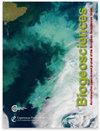调整用于土壤有机碳和无机碳定量的 Rock-Eval® 热分析方法
IF 3.9
2区 地球科学
Q1 ECOLOGY
引用次数: 0
摘要
摘要。量化土壤有机碳(SOC)和土壤无机碳(SIC)对于了解碳(C)动态和评估石灰性土壤固碳潜力至关重要。通常用于量化 SOC 和 SIC 的程序包括预处理(脱碳、去除碳酸盐)以及计算原始等分样品和预处理等分样品上元素分析估算的碳含量之间的差异。这些程序会导致与预处理相关的分析偏差、与样品异质性相关的测量偏差以及与计算相关的累积误差。Rock-Eval® 分析是一种斜坡式热分析,自 2000 年代以来一直用于土壤科学,包括样品热解和残留物氧化。对未经预处理的等分样品进行一次 Rock-Eval® 分析,可获得两个参数,分别估算样品中的有机碳含量(TOC)和无机碳含量(MinC)。不过,Rock-Eval® 方案是 IFP Energies Nouvelles 在 20 世纪 70 年代为研究含油岩石而标准化的,因此并不完全适用于土壤研究。以往的研究建议对标准参数进行统计修正,以改进对元素分析评估的碳含量的估算,但只有少数研究侧重于使用 MinC 参数估算无机碳含量。此外,他们都没有建议对标准的 Rock-Eval® 方案进行调整。本研究建议对该方案进行调整,以优化土壤样本中 SOC 和 SIC 的定量。在 30 个 SOC 和 SIC 含量范围广泛的农业表层土壤中,对元素分析法和 Rock-Eval® 法进行了 SOC 和 SIC 定量比较,并对标准 TOC 和 MinC 参数进行了统计修正。结果表明,一旦修正了 TOC 参数,标准 Rock-Eval® 协议就能正确估算 SOC 含量。但是,它无法对大于 4 毫克的 SIC 进行完全的热分解,从而导致 MinC 参数低估了高 SIC 含量,即使对其进行修正后也是如此。因此,最终氧化等温线延长至 7 分钟,以便在分析结束前完成 SIC 的热分解。这项工作在方法上迈出了一步,可以在一次分析运行中对未经预处理的等分样品进行 SOC 和 SIC 含量测量。还需要做更多的工作:(i) 在更广泛的土壤样本上进行,这些样本具有不同的土地利用和其他形式的碳酸盐矿物,以及采样深度;(ii) 避免使用 TOC 和 MinC 参数的统计校正。本文章由计算机程序翻译,如有差异,请以英文原文为准。
Adjustments to the Rock-Eval® thermal analysis for soil organic and inorganic carbon quantification
Abstract. Quantifying both soil organic carbon (SOC) and soil inorganic carbon (SIC) is essential to understand carbon (C) dynamics and to assess the atmospheric C sequestration potential in calcareous soils. The procedures usually used to quantify SOC and SIC involve pretreatments (decarbonation, carbonate removal) and calculations of the difference between C contents estimated by elemental analysis on raw and pretreated aliquots. These procedures lead to analytical bias associated with pretreatments, measurement deviations associated with sample heterogeneity, and cumulative errors associated with calculations. The Rock-Eval® analysis is a ramped thermal analysis that has been used in soil sciences since the 2000s, consisting of pyrolysis of the sample followed by oxidation of the residue. A single Rock-Eval® analysis on non-pretreated aliquots provides two parameters estimating the organic (TOC) and inorganic (MinC) C contents of the samples. Nevertheless, the Rock-Eval® protocol was standardised in the 1970s by IFP Energies Nouvelles for studying oil-bearing rocks and is thus not perfectly suited for soil study. Previous studies have suggested statistical corrections of the standard parameters to improve their estimations of C contents assessed by elemental analysis, but only a few of them have focused on the estimation of inorganic C content using the MinC parameter. Moreover, none of them have suggested adjustments to the standard Rock-Eval® protocol. This study proposes to adapt this protocol to optimise SOC and SIC quantifications in soil samples. Comparisons between SOC and SIC quantifications by elemental analysis and by Rock-Eval®, with and without statistical corrections of the standard TOC and MinC parameters, were carried out on 30 agricultural topsoils with a wide range of SOC and SIC contents. The results show that the standard Rock-Eval® protocol can properly estimate SOC contents once the TOC parameter is corrected. However, it cannot achieve a complete thermal breakdown of SIC amounts > 4 mg, leading to an underestimation of high SIC contents by the MinC parameter, even after correcting for this. Thus, the final oxidation isotherm is extended to 7 min to complete the thermal breakdown of SIC before the end of the analysis. This work is a methodological step to measure SOC and SIC contents in a single analytical run on a non-pretreated aliquot. More work is needed (i) on a wider range of soil samples with differing land use and other forms of carbonate mineral and sampling depths and (ii) to avoid the use of statistical corrections of the TOC and MinC parameters.
求助全文
通过发布文献求助,成功后即可免费获取论文全文。
去求助
来源期刊

Biogeosciences
环境科学-地球科学综合
CiteScore
8.60
自引率
8.20%
发文量
258
审稿时长
4.2 months
期刊介绍:
Biogeosciences (BG) is an international scientific journal dedicated to the publication and discussion of research articles, short communications and review papers on all aspects of the interactions between the biological, chemical and physical processes in terrestrial or extraterrestrial life with the geosphere, hydrosphere and atmosphere. The objective of the journal is to cut across the boundaries of established sciences and achieve an interdisciplinary view of these interactions. Experimental, conceptual and modelling approaches are welcome.
 求助内容:
求助内容: 应助结果提醒方式:
应助结果提醒方式:


